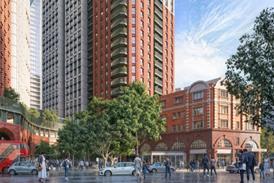After decades of inertia, the regulator is forcing long-overdue reform. But, Ben Flatman argues, without clearer leadership from within the profession, the bigger questions remain unanswered

What stood out most in my recent interview with Architects Registration Board (ARB) chief executive Hugh Simpson was how clearly it exposed the lack of strategic vision and high-level debate within the profession itself about the major challenges that architects face. For decades, architecture in the UK has muddled along with outdated structures and little shared direction.
Hugh Simpson is not an architect, nor does he come from a built environment background. Yet, perhaps because of this outsider status, he seems more attuned to some of the profession’s long-term strategic failures than many within it.
In our conversation, what became clear was his view that, where the profession has failed to reform itself, and where that failure risks undermining public confidence, the regulator has a duty to step in.
ARB is confronting some of the profession’s most deeply entrenched problems and showing what can be achieved with purpose and intent
Under his leadership, ARB has taken a broad and, to some, controversial view of its remit. It has introduced compulsory continuing professional development (CPD), driven major education reforms, and begun tackling issues of access, equity and diversity.
It is also seeking to address one of the sector’s most persistent failings: the inability of many practices to provide consistently high-quality professional practical experience for those training to join the register. ARB is confronting some of the profession’s most deeply entrenched problems and showing what can be achieved with purpose and intent.
Take the archaic three-part qualification model. Dating back to the 1950s, it has long acted as a barrier to access and diversity. The drawn-out and expensive route to registration has left many disillusioned, often saddled with huge debts and arguably lacking the skills needed for the workplace. It has been clear for years that the system does not work, and yet inertia held sway.

Now, thanks to reforms led by Simpson and his team, alternative pathways to registration are emerging, with new emphasis on competence rather than time served. These changes go beyond minor tweaks. They signal a shift towards a more flexible and inclusive profession.
Simpson is unapologetic about ARB’s transformation into what he calls an “activist regulator”. In doing so, the organisation is arguably stepping into a vacuum that should be filled by a professional body with a long-term vision.
ARB is a regulator, not a representative organisation. But the reality is that no one else seems willing or able to articulate what the profession could and should become in 10 or 20 years’ time.
This could be a moment for architects to lead once again on competence, risk and responsibility
This raises an urgent question: who is leading architecture’s long-term thinking? Because architecture needs more than piecemeal reform. It needs a consistent vision for its future, a future in which it is not simply coping but growing in strength and relevance.
In our interview, we touched on the idea of a reserved function, also known as protection of function, for architects. While still at an early stage, the principal designer role under the Building Safety Act presents a rare opportunity to reclaim lost ground. This could be a moment for architects to lead once again on competence, risk and responsibility.
If seized, it could help to drive higher fees, better salaries and stronger professional standing. But that depends on the profession having the confidence and coordination to step forward.
Too often, UK architecture seems downcast, absorbed in crisis or trapped in cycles of introspection. Fees are squeezed, status is diminished, and looming threats such as AI remain poorly understood.
Meanwhile, the RIBA, for all its excellent work, struggles to define its role. Its royal charter does not even mention its members. Presidents come and go in two-year bursts, rarely with time to establish lasting impact or speak with authority at a national level.
The result is often a deafening silence in the media and at government level, not the coherent chorus that is required. Currently there is little chance of strategic advocacy cutting through.
The real question now is whether the profession is ready to step up itself
We need a profession which knows what it stands for, and can speak with clarity and consistency about the future it wants. That requires leadership and a rethinking of how we cultivate it. It also means asking difficult questions.
Should architects specialise more, as many already do in practice? Should our education and registration systems reflect a wider range of roles, skills and career paths? The Royal Institution of Chartered Surveyors (RICS) has embraced this, offering 22 different professional pathways. Why is architecture still clinging to a generalist model that arguably serves no one well?
Simpson expressed surprise that this debate is not already happening. But it is not the regulator’s job to answer these questions. ARB’s remit is clear and relatively narrow. It sets and enforces standards to protect the public. It is not responsible for defining the professional identity or future direction of architecture in the UK.
And yet, at a time when others have gone quiet, it is ARB’s recent work that is helping to reframe architecture as a more socially responsive and publicly accountable profession. This includes reforms to education and practical training, a renewed focus on competence and ethics, and a willingness to challenge longstanding orthodoxy.
Simpson is right: the future of the profession is not the regulator’s responsibility. But, in the current vacuum, ARB’s interventions show what is possible with a clear understanding of the strategic challenges.
None of this is to deny that important conversations are already happening. Across the country, many architects are thinking hard about the future of the profession and actively seeking to provide leadership. But in the absence of strategic consensus or a shared direction, these efforts risk becoming fragmented. What is missing is an overarching framework that can knit these strands together into a clear and compelling vision.
For all its flaws, RIBA remains the most viable platform for such a mission. Excellent presidents come and go, but the structure does not allow for long-term leadership. Perhaps a concerted campaign is needed to reshape RIBA’s charter, giving it an explicit focus on its members and the profession as a whole.
A permanent spokesperson role could offer consistent representation and national visibility. Ideally that figure would be an architect, but we should not be precious about this. Sometimes what is needed most is an outsider with the distance and clarity to grasp the scale of the challenge and see new possibilities.
The real question now is whether the profession is ready to step up, not just as individuals, but collectively, through its institutions, to imagine something better and build it.

>> Also read: The regulator steps into the spotlight
Ben Flatman meets Hugh Simpson, chief executive of the Architects Registration Board, to discuss education reform, CPD and the future of regulation – and why he is happy for ARB to be an “activist regulator”.Postscript
Ben Flatman is Building Design’s architectural editor.
















2 Readers' comments